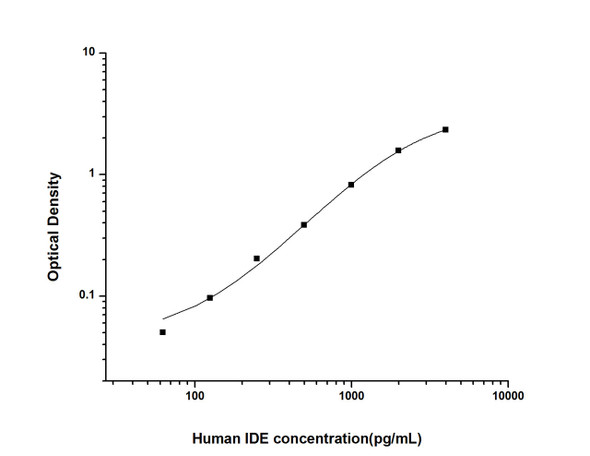Human Immunology ELISA Kits 1
Human IDE (Insulin Degrading Enzyme) CLIA Kit (HUES00310)
- SKU:
- HUES00310
- Product Type:
- ELISA Kit
- ELISA Type:
- CLIA Kit
- Size:
- 96 Assays
- Sensitivity:
- 9.38pg/mL
- Range:
- 15.63-1000pg/mL
- ELISA Type:
- Sandwich
- Synonyms:
- Insulysin, Insulin protease
- Reactivity:
- Human
- Sample Type:
- Serum, plasma and other biological fluids
- Research Area:
- Immunology
Description
| Assay type: | Sandwich |
| Format: | 96T |
| Assay time: | 4.5h |
| Reactivity: | Human |
| Detection method: | Chemiluminescence |
| Detection range: | 15.63-1000 pg/mL |
| Sensitivity: | 9.38 pg/mL |
| Sample volume: | 100µL |
| Sample type: | Serum, plasma and other biological fluids |
| Repeatability: | CV < 15% |
| Specificity: | This kit recognizes Human IDE in samples. No significant cross-reactivity or interference between Human IDE and analogues was observed. |
This kit uses Sandwich-CLIA as the method. The micro CLIA plate provided in this kit has been pre-coated with an antibody specific to Human IDE. Standards or samples are added to the appropriate micro CLIA plate wells and combined with the specific antibody. Then a biotinylated detection antibody specific for Human IDE and Avidin-Horseradish Peroxidase (HRP) conjugate are added to each micro plate well successively and incubated. Free components are washed away. The substrate solution is added to each well. Only those wells that contain Human IDE, biotinylated detection antibody and Avidin-HRP conjugate will appear fluorescence. The Relative light unit (RLU) value is measured spectrophotometrically by the Chemiluminescence immunoassay analyzer. The RLU value is positively associated with the concentration of Human IDE. The concentration of Human IDE in the samples can be calculated by comparing the RLU of the samples to the standard curve.
| UniProt Protein Function: | IDE: Plays a role in the cellular breakdown of insulin, IAPP, glucagon, bradykinin, kallidin and other peptides, and thereby plays a role in intercellular peptide signaling. Degrades amyloid formed by APP and IAPP. May play a role in the degradation and clearance of naturally secreted amyloid beta-protein by neurons and microglia. Belongs to the peptidase M16 family. 2 isoforms of the human protein are produced by alternative splicing. |
| UniProt Protein Details: | Protein type:Cell surface; EC 3. 4. 24. 56; Nuclear receptor co-regulator; Protease Chromosomal Location of Human Ortholog: 10q23. 33 Cellular Component: cell surface; cytoplasm; cytosol; extracellular space; mitochondrion; nucleus; peroxisome Molecular Function:ATP binding; glycoprotein binding; insulin binding; metalloendopeptidase activity; peptide binding; protein binding; protein homodimerization activity; receptor binding; ubiquitin binding; zinc ion binding Biological Process: beta-amyloid metabolic process; determination of adult life span; positive regulation of protein oligomerization; protein homooligomerization; proteolysis; proteolysis involved in cellular protein catabolic process |
| NCBI Summary: | This gene encodes a zinc metallopeptidase that degrades intracellular insulin, and thereby terminates insulins activity, as well as participating in intercellular peptide signalling by degrading diverse peptides such as glucagon, amylin, bradykinin, and kallidin. The preferential affinity of this enzyme for insulin results in insulin-mediated inhibition of the degradation of other peptides such as beta-amyloid. Deficiencies in this protein's function are associated with Alzheimer's disease and type 2 diabetes mellitus but mutations in this gene have not been shown to be causitive for these diseases. This protein localizes primarily to the cytoplasm but in some cell types localizes to the extracellular space, cell membrane, peroxisome, and mitochondrion. Alternative splicing results in multiple transcript variants encoding distinct isoforms. Additional transcript variants have been described but have not been experimentally verified. [provided by RefSeq, Sep 2009] |
| UniProt Code: | P14735 |
| NCBI GenInfo Identifier: | 215274252 |
| NCBI Gene ID: | 3416 |
| NCBI Accession: | P14735. 4 |
| UniProt Secondary Accession: | P14735,Q5T5N2, B2R721, B7ZAU2, D3DR35, |
| UniProt Related Accession: | P14735 |
| Molecular Weight: | 118kDa |
| NCBI Full Name: | Insulin-degrading enzyme |
| NCBI Synonym Full Names: | insulin degrading enzyme |
| NCBI Official Symbol: | IDE |
| NCBI Official Synonym Symbols: | INSULYSIN |
| NCBI Protein Information: | insulin-degrading enzyme |
| UniProt Protein Name: | Insulin-degrading enzyme |
| UniProt Synonym Protein Names: | Abeta-degrading protease; Insulin protease; Insulinase; Insulysin |
| Protein Family: | IgM protease |
| UniProt Gene Name: | IDE |
As the RLU values of the standard curve may vary according to the conditions of the actual assay performance (e. g. operator, pipetting technique, washing technique or temperature effects), the operator should establish a standard curve for each test. Typical standard curve and data is provided below for reference only.
| Concentration (pg/mL) | RLU | Average | Corrected |
| 1000 | 51347 56003 | 53675 | 53650 |
| 500 | 21304 23674 | 22489 | 22464 |
| 250 | 10539 9883 | 10211 | 10186 |
| 125 | 4615 5187 | 4901 | 4876 |
| 62.5 | 2470 2436 | 2453 | 2428 |
| 31.25 | 1331 1231 | 1281 | 1256 |
| 15.63 | 686 730 | 708 | 683 |
| 0 | 25 25 | 25 | -- |
Precision
Intra-assay Precision (Precision within an assay): 3 samples with low, mid range and high level Human IDE were tested 20 times on one plate, respectively.
Inter-assay Precision (Precision between assays): 3 samples with low, mid range and high level Human IDE were tested on 3 different plates, 20 replicates in each plate.
| Intra-assay Precision | Inter-assay Precision | |||||
| Sample | 1 | 2 | 3 | 1 | 2 | 3 |
| n | 20 | 20 | 20 | 20 | 20 | 20 |
| Mean (pg/mL) | 49.47 | 111.52 | 391.00 | 48.69 | 108.49 | 395.33 |
| Standard deviation | 6.33 | 9.32 | 25.42 | 4.27 | 10.66 | 43.37 |
| C V (%) | 12.80 | 8.36 | 6.50 | 8.77 | 9.83 | 10.97 |
Recovery
The recovery of Human IDE spiked at three different levels in samples throughout the range of the assay was evaluated in various matrices.
| Sample Type | Range (%) | Average Recovery (%) |
| Serum (n=5) | 86-99 | 92 |
| EDTA plasma (n=5) | 98-113 | 104 |
| Cell culture media (n=5) | 88-101 | 94 |
Linearity
Samples were spiked with high concentrations of Human IDE and diluted with Reference Standard & Sample Diluent to produce samples with values within the range of the assay.
| Serum (n=5) | EDTA plasma (n=5) | Cell culture media (n=5) | ||
| 1:2 | Range (%) | 91-105 | 94-108 | 86-97 |
| Average (%) | 98 | 99 | 91 | |
| 1:4 | Range (%) | 101-116 | 87-101 | 103-117 |
| Average (%) | 107 | 93 | 109 | |
| 1:8 | Range (%) | 87-101 | 98-111 | 91-103 |
| Average (%) | 92 | 104 | 96 | |
| 1:16 | Range (%) | 88-99 | 96-113 | 103-119 |
| Average (%) | 94 | 103 | 109 |
An unopened kit can be stored at 4°C for 1 month. If the kit is not used within 1 month, store the items separately according to the following conditions once the kit is received.
| Item | Specifications | Storage |
| Micro CLIA Plate(Dismountable) | 8 wells ×12 strips | -20°C, 6 months |
| Reference Standard | 2 vials | |
| Concentrated Biotinylated Detection Ab (100×) | 1 vial, 120 µL | |
| Concentrated HRP Conjugate (100×) | 1 vial, 120 µL | -20°C(shading light), 6 months |
| Reference Standard & Sample Diluent | 1 vial, 20 mL | 4°C, 6 months |
| Biotinylated Detection Ab Diluent | 1 vial, 14 mL | |
| HRP Conjugate Diluent | 1 vial, 14 mL | |
| Concentrated Wash Buffer (25×) | 1 vial, 30 mL | |
| Substrate Reagent A | 1 vial, 5 mL | 4°C (shading light) |
| Substrate Reagent B | 1 vial, 5 mL | 4°C (shading light) |
| Plate Sealer | 5 pieces | |
| Product Description | 1 copy | |
| Certificate of Analysis | 1 copy |
- Set standard, test sample and control (zero) wells on the pre-coated plate and record theirpositions. It is recommended to measure each standard and sample in duplicate. Note: addall solutions to the bottom of the plate wells while avoiding contact with the well walls. Ensuresolutions do not foam when adding to the wells.
- Aliquot 100µl of standard solutions into the standard wells.
- Add 100µl of Sample / Standard dilution buffer into the control (zero) well.
- Add 100µl of properly diluted sample (serum, plasma, tissue homogenates and otherbiological fluids. ) into test sample wells.
- Cover the plate with the sealer provided in the kit and incubate for 90 min at 37°C.
- Aspirate the liquid from each well, do not wash. Immediately add 100µL of BiotinylatedDetection Ab working solution to each well. Cover the plate with a plate seal and gently mix. Incubate for 1 hour at 37°C.
- Aspirate or decant the solution from the plate and add 350µL of wash buffer to each welland incubate for 1-2 minutes at room temperature. Aspirate the solution from each well andclap the plate on absorbent filter paper to dry. Repeat this process 3 times. Note: a microplatewasher can be used in this step and other wash steps.
- Add 100µL of HRP Conjugate working solution to each well. Cover with a plate seal andincubate for 30 min at 37°C.
- Aspirate or decant the solution from each well. Repeat the wash process for five times asconducted in step 7.
- Add 100µL of Substrate mixture solution to each well. Cover with a new plate seal andincubate for no more than 5 min at 37°C. Protect the plate from light.
- Determine the RLU value of each well immediately.






